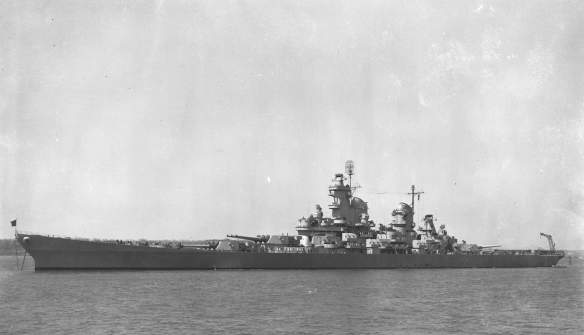USS Iowa (BB-61) during her shakedown period on April 4th, 1943.
Joseph Stalin, Franklin D. Roosevelt, and Winston Churchill on the verandah of the Soviet Embassy in Tehran during the Tehran Conference.
A potentially catastrophic blue-on-blue was the launch of a live torpedo by the US Navy destroyer Willam D Porter aimed directly at the battleship USS Iowa, carrying US President Franklin D Roosevelt, Secretary of State Cordell Hull, and high-ranking military and naval personnel including Admiral King, Chief of Naval Operations. They were en route to meet Churchill at Cairo and then Stalin at the Teheran Conference.
Early on 14 November 1943 the Iowa and her destroyers were east of Bermuda, and it was decided to show the president how Iowa could defend herself against an air attack. Several weather balloons were launched to serve as targets, and more than a hundred AA guns opened fire. One of Iowa’s escorts was the new Fletcher-class destroyer USS William D Porter. In her brief career Porter had already begun to acquire a certain reputation for misadventure. Going astern from her moorings to begin the mission she had brushed the side of a sister-ship, carrying away the other’s boats and tackle. While en route to Bermuda the Porter had accidentally loosed a depth charge, causing general alarm. Now the jinxed ship was ready for the big one.
As her commander, Captain Walker, called his crew to action stations and gave the order to join in the firing at the aerial targets, her torpedo officer decided it would be a good opportunity to carry out a torpedo-firing exercise. Training the pentad mounts to port, he lined up the bulk of Iowa in his torpedo director sights. The battleship was just 6000yds away when he began to go through his ritual to space out the shots of a spread. He pressed the firing button on the bridge to simulate launching the torpedo from tube No 1. Calmly reciting the required phrase, ‘If I wasn’t a torpedo officer, I wouldn’t be here,’ he pressed the firing button for tube No 2. ‘If I wasn’t a torpedo officer, I wouldn’t be here,’ and he pressed the button for tube No 3. His ritual was interrupted by the unmistakable sound of a live torpedo being launched from the tube.
Up on the bridge Lieutenant Lewis turned to his captain and innocently asked if he had given the order to fire a torpedo. General panic broke out as the torpedo headed for the president’s ship. Porter’s signalman flashed out a warning by signal lamp, but inadvertently warned that the torpedo was heading in the opposite direction. He then sent a correction, but used the code sequence indicating that Porter herself was going full speed in reverse.
Finally, the captain authorised breaking radio silence and Porter’s radioman sent the message ‘Lion [the codename for Iowa], Lion, come right’. The Iowa’s radio operator was concerned at the breaking of radio silence and demanded the sender identify himself. Eventually, the message got through, and Iowa put on speed and turned to port, to comb the track of the fast-approaching torpedo. The increased wash of her propellers luckily caused the torpedo to explode harmlessly astern of her.
In the meantime, President Roosevelt, who had heard the announcement of an approaching torpedo, moved his wheelchair over to the bridge wing to observe what was happening. It is reported that his Secret Service bodyguard actually drew his pistol, ready to shoot at the warhead of the offending torpedo – shades of the French navy of the 1880s shooting at torpedoes with their repeater rifles.
When Iowa enquired who had launched the torpedo, Captain Walker weakly replied, ‘We did it.’ The Iowa accordingly trained her guns on the unfortunate Porter, which was suspected of being the instigator of an assassination attempt. The Porter was ordered to Bermuda, where the ship was surrounded by armed Marines while the official enquiry was conducted behind closed doors. This uncovered the fact that Lawton Dawson, the torpedo-man responsible for inserting the torpedo launching charges for action, and then removing them before a practice launch, had inadvertently left in place the charge for tube No 3. To try to cover up his mistake he had even thrown the fired case overboard, to no avail.
Torpedo-man Dawson eventually confessed, and was sentenced to fourteen years’ hard labour. His sentence was later commuted by President Roosevelt who asked that no punishment be handed out for what was clearly an accident. Someone had to carry the blame, however, so Captain Walker and several of his crew were drafted to mundane shore assignments.
It is interesting to note that an earlier torpedo boat named Porter (TB-6) had fired a torpedo at the armoured cruiser New York during a night engagement off Cuba in 1898, also luckily missing.
